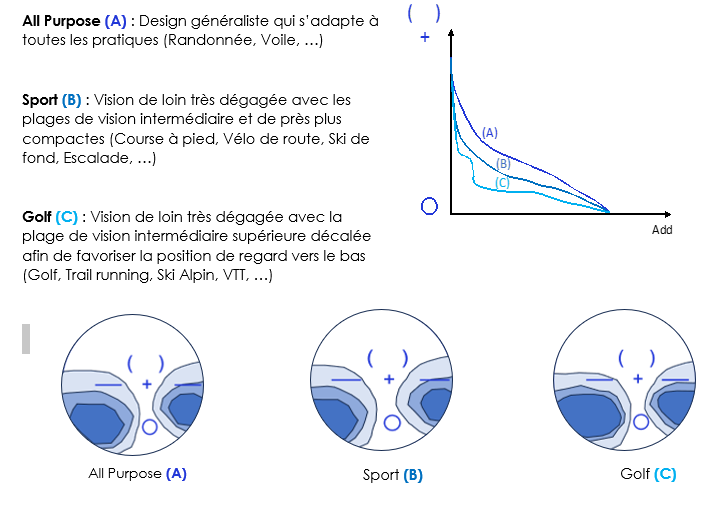Presbyopia, instructions for use:
From the age of fifty, we are all affected by a physiological phenomenon called presbyopia: this results in increasingly blurred near vision and a need to extend the reading distance until the arms become too short…
This well-known phenomenon is treated by using variable focus lenses, in other words progressive lenses:
The upper part of the lens is dedicated to distance vision, the middle part is for intermediate vision (it is this area of progression of the power of the lens which gave it its name) and the lower part corresponds to near vision.

While progressive lenses are quite well tolerated on our everyday glasses, they don’t have such a good reputation when it comes to prescription sports glasses! So, are progressive lenses on sports glasses a good or bad idea?
So, are progressive lenses useful for sports?
At first glance, you might think that when you’re skiing, running or cycling, the important thing is to be able to see well from a distance. Sure, but what about when you need to use your near vision?
We all have our mobile phone in our pocket that harasses us with notifications, our GPS watch on our wrist that tells us all our essential parameters for trail running (How did we do it before? Well, we didn’t…!) And what about the Garmin that sits in the middle of the handlebars of our bike, let alone the need to repair a puncture at the side of the road.
In conclusion, we believe that during a sporting activity, only distance vision counts, but the reality is quite different. So, unless you carry your daily pair of glasses in the back pocket of your jersey or bag, progressive sports lenses are ESSENTIAL!
What should we expect?
So, once you are ready to take the plunge, you still need to integrate some very important parameters so that the adaptation takes place in the best possible conditions.
Indeed, progressive sports lenses require a new adaptation phase, such as the one you experienced with your everyday glasses. Here are the reasons:
Sports frames are curved to cover and protect the eyes. This curved geometry requires the use of corrective lenses of the same geometry, i.e. cambered lenses. However, in optics, when an optical surface (the corrective lens) is tilted relative to the visual axis, an optical deviation is created. If we add to this a second, vertical tilt, called the pantoscopic angle, and increase the lens-eye distance, we obtain a certain number of modifications and distortions that must be compensated for. This is why, when manufacturing your sports corrective lenses (progressive or single focus), we will integrate all the technical parameters of the frame in order to create THE pair adapted to your vision and the frame in question. As you will have understood, each pair of lenses is personalized to the chosen frame!
The corrections displayed are therefore no longer exactly those prescribed, but are the results of complex calculations which allow vision to be restored.
The consequence is that we will have to teach our brain a new way of perceiving its environment, explanations:
The first feeling when you put on your sports prescription glasses (progressive and single vision) will be quite unsettling. You will have an impression of pitching and a magnifying effect. To avoid this, a few useful tips are necessary:
- You have to look straight ahead and to look to the sides, your head will spin.
- For intermediate and near distances, start from the upper part (distance vision) and lower the eyes, adjusting as you go by tilting the head slightly downward.
- If you feel any confusion, quickly return to the primary distance vision position.
What type of progressive lenses for what type of sport?
At METAOPTICS, we have selected 3 different designs to cover all your needs. If you have a “multi-sport” use, choose the generalist “All Purpose” design.

What you need to remember:
- Yes, progressive lenses for sports are a very good idea!
- First of all, they should be used in calm and rather static situations: avoid driving or very dynamic situations in the first few hours.
- A more or less long period of adaptation is to be expected.
- You should feel levels of improvement as you use it.
- Once we have integrated this new way of working, let’s go, we can step on the gas!
- The adaptation is done once and for all. Your brain will switch from one pair of glasses to another in a few seconds!
- Every sport has its own appropriate design. Ask us for advice if you are unsure!






